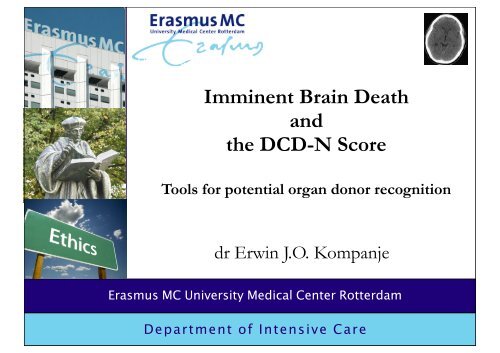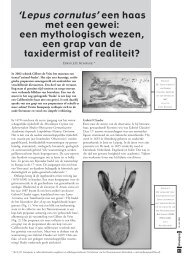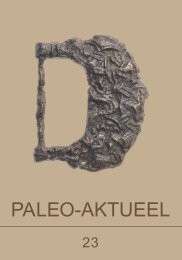Imminent Brain Death and the DCD-N Score
1. Recognition of the potential brain- dead organ donor - dr Erwin JO ...
1. Recognition of the potential brain- dead organ donor - dr Erwin JO ...
- No tags were found...
Create successful ePaper yourself
Turn your PDF publications into a flip-book with our unique Google optimized e-Paper software.
<strong>Imminent</strong> <strong>Brain</strong> <strong>Death</strong><br />
<strong>and</strong><br />
<strong>the</strong> <strong>DCD</strong>-N <strong>Score</strong><br />
Tools for potential organ donor recognition<br />
dr Erwin J.O. Kompanje<br />
Erasmus MC University Medical Center Rotterdam<br />
Department of Intensive Care
Organ transplantation<br />
Department of Intensive Care Adults<br />
Erasmus MC University Medical Center Rotterdam<br />
Problems in 1950-1970<br />
1.Warm ischemia of <strong>the</strong> dead donor<br />
2. Rejection of <strong>the</strong> transplanted organ<br />
Problems nowadays<br />
1. Low availability of donor organs (more<br />
patients on <strong>the</strong> waiting lists than donororgans<br />
available)<br />
2. Long term co-morbidity (malignancies)<br />
after transplantation
Department of Intensive Care Adults<br />
Erasmus MC University Medical Center Rotterdam<br />
Waiting list <strong>and</strong><br />
supply of kidneys
Department of Intensive Care Adults<br />
Erasmus MC University Medical Center Rotterdam<br />
Waiting list <strong>and</strong><br />
supply of hearts
Department of Intensive Care Adults<br />
Erasmus MC University Medical Center Rotterdam<br />
Donation rates (per million/population)<br />
in <strong>the</strong> European Union (2007)
Department of Intensive Care Adults<br />
Erasmus MC University Medical Center Rotterdam<br />
Most important reasons for low number of<br />
donor organs<br />
1. Progress in effective prevention <strong>and</strong> effective<br />
treatment of acute neurological conditions<br />
2. Refusal to donate organs of a deceased<br />
relative<br />
3. Non-recognition of a potential organ donor<br />
by professionals
Department of Intensive Care Adults<br />
Erasmus MC University Medical Center Rotterdam<br />
<strong>Brain</strong> death is, <strong>and</strong> has always been, a rare<br />
outcome of neuro-critical care in a selected<br />
cohort of patients<br />
c. 3% of all patients who die on a neurocritical<br />
care unit die from brain death. Less than 1%<br />
on general ICUs.
Department of Intensive Care Adults<br />
Erasmus MC University Medical Center Rotterdam<br />
<strong>Brain</strong> death, underlying conditions<br />
Analysis of 71 series (1968-2008)<br />
N= 6317 [83% SAH, TBI, ICH]<br />
60% SAH, 8% ICH 15% TBI<br />
Kompanje, 2009
Department of Intensive Care Adults<br />
Erasmus MC University Medical Center Rotterdam
Department of Intensive Care Adults<br />
Erasmus MC University Medical Center Rotterdam
Afdeling Intensive Care Volwassenen<br />
Erasmus MC Universitair Medisch Centrum Rotterdam<br />
‘Between 1970 <strong>and</strong> 1999, total traffic fatalities<br />
declined, on average by 35% in 32 European<br />
countries <strong>and</strong> USA, while total vehicle kilometres<br />
driven increased by over 250%’
Department of Intensive Care Adults<br />
Erasmus MC University Medical Center Rotterdam<br />
How to increase <strong>the</strong> number of<br />
donor organs?<br />
1. Increase living organ donation<br />
2. Lowering family refusal<br />
3. Better potential organ donor recognition leading<br />
to a better Donor Conversion Rate
Organ donor recognition<br />
Department of Intensive Care Adults<br />
Erasmus MC University Medical Center Rotterdam<br />
1. Recognition of <strong>the</strong> potential braindead<br />
organ donor<br />
2. Recognition of <strong>the</strong> potential circulatory death<br />
donor
Department of Intensive Care Adults<br />
Erasmus MC University Medical Center Rotterdam
Department of Intensive Care Adults<br />
Erasmus MC University Medical Center Rotterdam
Department of Intensive Care Adults<br />
Erasmus MC University Medical Center Rotterdam
<strong>Imminent</strong> brain death<br />
Department of Intensive Care Adults<br />
Erasmus MC University Medical Center Rotterdam
Department of Intensive Care Adults<br />
Erasmus MC University Medical Center Rotterdam
<strong>Imminent</strong> brain death<br />
Department of Intensive Care Adults<br />
Erasmus MC University Medical Center Rotterdam
Organ donor recognition<br />
Department of Intensive Care Adults<br />
Erasmus MC University Medical Center Rotterdam<br />
1. Recognition of <strong>the</strong> potential brain-dead organ<br />
donor<br />
2. Recognition of <strong>the</strong> potential<br />
circulatory death donor
Department of Intensive Care Adults<br />
Erasmus MC University Medical Center Rotterdam
Department of Intensive Care Adults<br />
Erasmus MC University Medical Center Rotterdam
Department of Intensive Care Adults<br />
Erasmus MC University Medical Center Rotterdam
Department of Intensive Care Adults<br />
Erasmus MC University Medical Center Rotterdam
Department of Intensive Care Adults<br />
Erasmus MC University Medical Center Rotterdam
Department of Intensive Care Adults<br />
Erasmus MC University Medical Center Rotterdam
Department of Intensive Care Adults<br />
Erasmus MC University Medical Center Rotterdam
Department of Intensive Care Adults<br />
Erasmus MC University Medical Center Rotterdam
Department of Intensive Care Adults<br />
Erasmus MC University Medical Center Rotterdam
Department of Intensive Care Adults<br />
Erasmus MC University Medical Center Rotterdam
Department of Intensive Care Adults<br />
Erasmus MC University Medical Center Rotterdam
Conclusions<br />
Department of Intensive Care Adults<br />
Erasmus MC University Medical Center Rotterdam<br />
1. Uniform definition of a potential brain dead<br />
organ donor (imminent brain death) will lead to<br />
higher donor conversion rate <strong>and</strong> allows better<br />
comparison between countries <strong>and</strong> hospitals<br />
2. Using <strong>the</strong> <strong>DCD</strong>-N score will predict death<br />
within 60 minutes after withdrawal of life support<br />
which will lead to a higher donor conversion<br />
rate, less burden for relatives <strong>and</strong> better use of<br />
resources
Department of Intensive Care Adults<br />
Erasmus MC University Medical Center Rotterdam








